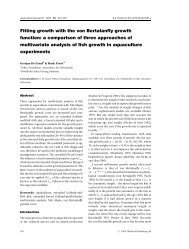RAPPORT GENERAL DE L'ATELIER ... - Nefisco.org
RAPPORT GENERAL DE L'ATELIER ... - Nefisco.org
RAPPORT GENERAL DE L'ATELIER ... - Nefisco.org
Create successful ePaper yourself
Turn your PDF publications into a flip-book with our unique Google optimized e-Paper software.
168<br />
The paper highlights the strategies, activities, achievements and constraints of the project<br />
including experiences and lessons learnt in the course of the project.<br />
Socio-economic, fish species and their methods of exploitation.<br />
Several socio-economic surveys were carried out before and immediately on the<br />
commencement of the project (Alamu and Mdaihli, 1993; Okomoda et al, 1995; Ibeun and<br />
Mdaihli, 1994). One of the surveys (Alamu and Mdaihli, 1993) revealed that 72% of the<br />
fishermen were in the age bracket of between 21- 50 years. About 79% of the ethnic<br />
composition is Hausa from Kebbi and Sokoto States. These are migrants but professional<br />
fishermen who inherited fishing from their ancestors. About 98% of them are Moslems. The<br />
literacy level is very low (less than 2%). The main source of income is fishing with about<br />
95% of them on full-time basis.<br />
Farming, that is a seasonal occupation on the other hand, is practiced on subsistence basis.<br />
Hausa language which is the language spoken by the majority of the people is the medium of<br />
communication. Local traditional administration is well established. There is an existing<br />
hierarchy, as any contact with the community has to be routed through the council of elders.<br />
The village Head serves as the highest symbol of authority in each community. Other<br />
traditional titleholders who the village has to consult on matters affecting the general welfare<br />
of the people are under his jurisdiction. Matters that cannot be settled by this council are<br />
referred to the District Head and finally to the Emir for final decision.<br />
As a result of the Islamic injunction of purdah, married women within child bearing age<br />
bracket are not allowed to carry out any economic activity outside their fenced compounds<br />
and are therefore dependent on their husbands for sustenance.<br />
STOCK ENHANCEMENT AND PROPERTY RIGHTS<br />
Stock enhancement<br />
The first three years of the project captioned ‘’orientation phase’’ was devoted to conducting<br />
surveys to reveal the dynamics of the fisheries and assist in evolving a management plan for<br />
the Lake area. The surveys included the frame (total number of fishermen and women,<br />
number of fishing villages, fishing gear and crafts etc.), catch assessment and socio-economic.<br />
According to du Feu and Abayomi (1997), the trend indicated a decline in the number of<br />
gillnets and longlines whilst the driftnet and especially the beach seine fishery were<br />
expanding. du Feu and Abiodun (1998) further indicated that very small mesh sizes of the<br />
various fishing gears were in use.<br />
The mean mesh size for gillnet was put at 2.8’’, drift net 1.8’’, beach seines 0.12’’ and cast<br />
nets 1.8’’. An assessment of the level of destruction of the fishing gears singled out the beach<br />
seine as the first to be banned on the Lake. According to du Feu (1997), between September<br />
and December, the by- catches of beach seine reached up to 60% of its total catch, thereby<br />
endangering the recruitment of fish species such as Citharinus citharus, Synodontis<br />
membranaceous, Alestes sp and Lates niloticus. Because of this revelation, extension work<br />
started to concentrate its messages on the destructive impact of beach seining in 1996 after the<br />
number of beach seines had increased by 30% from 618 (1995) to 810 (1996). The extension<br />
work plus the inclusion of the ban into the fisheries law of both Kebbi and Niger States 1997<br />
Fisheries Edicts resulted in a drop of beach seine numbers to 582 in 1997 and 487 in 1998.<br />
Because of the controversy surrounding the removal/ ban of beach seines by the project and<br />
conflict between beach seiners and non-beach seiners (which comprised about 17% of all<br />
fishermen/ entrepreneurs), series of meetings were held with the major stakeholders (fish<br />
l’atelier international sur l’“amplification des ressources halieutiques a travers la gestion participative: Leçons et perspectives,du<br />
12 au 14 Décembre 2002, Bobo-Dioulasso,,Burkina Faso



